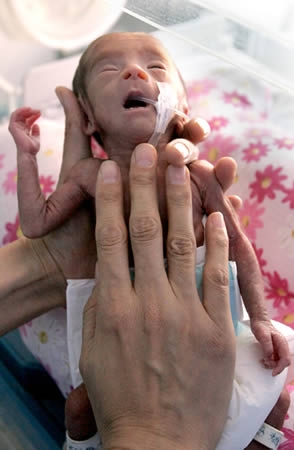By Brian L. Grant MD

Rafi, now age 3, was born premature at 28 weeks unable to maintain body temperature, breath or feed unassisted. He spent a month in the Neonatal Intensive Care Unit and is alive now because of a multidisciplinary team, medicine and technology.
The photo of the boy holding the flustered chick is my three-year-old grandson Rafi. He is perfect in every way. But his life is a triumph of medicine and technology. Rafi was born at 28 weeks of age, after an unexpected premature labor. His mother was rushed to deliver at the University of Washington. When born, he looked similar to the photo below. The delivery of such a small baby was easy. But what followed was not. A large team took over in the Neonatal Intensive Care Unit (NICU) and for the next four weeks, Rafi was watched and cared for. He was unable to maintain body temperature, feed or fully breathe unassisted – so others helped. After a month in that unit, he spent another month in a less intensive unit in Seattle before discharge at what would have been about 36 week’s gestation.
Absent the care he received, he would have died at birth. He had no apparent abnormalities beyond prematurity, and being kept alive while being allowed to mature took care of the issue. His situation is hardly unique, as the article, “In Premies, Better Care Also Means Hard Choice,” from the New York Times describes. The article focuses on the decision(s) to resuscitate premies.
 In Rafi’s case, there was no discussion, just action. Perhaps had there been severe problems or anomalies there might have been, but it appeared to be a given by the system that he would be given all resources available. I can’t imagine the challenge his parents would have faced had they been asked to make a life or death decision at that trying time. And they and we are very appreciative of the incredible care Rafi received by a skilled multidisciplinary team. The actual cost is not known to me, but I assume it was well into the six figures – covered by his parent’s insurance without challenge. Such tertiary care resources are expensive. But Rafi shared the unit with babies from less fortunate backgrounds, who received the same level of attention. While payment for and cost of care is a big issue for all of us, the source or availability of payment played absolutely no role once a baby was admitted.
In Rafi’s case, there was no discussion, just action. Perhaps had there been severe problems or anomalies there might have been, but it appeared to be a given by the system that he would be given all resources available. I can’t imagine the challenge his parents would have faced had they been asked to make a life or death decision at that trying time. And they and we are very appreciative of the incredible care Rafi received by a skilled multidisciplinary team. The actual cost is not known to me, but I assume it was well into the six figures – covered by his parent’s insurance without challenge. Such tertiary care resources are expensive. But Rafi shared the unit with babies from less fortunate backgrounds, who received the same level of attention. While payment for and cost of care is a big issue for all of us, the source or availability of payment played absolutely no role once a baby was admitted.
When I was a medical student on the late 70’s, one of my first clinical rotations was in a NICU. My first exposure to babies was of the two-pound variety, such that when I finally worked with full-term babies, I could not believe how big they were! The technology and skills to sustain these kids and avoid long-term problems continue to evolve and even then, I concluded that this is one area of medicine that truly has an impact – lives are saved that would have ended and many or most go on to lead normal lives. But challenges remain, especially in earlier gestation births. The ethical questions and values that the choices that were not available until recently are many. And each baby, family and set of resources creates a different set of opportunities as well as challenges. Read More…

This is a very interesting issue, and it is amazing to think that a baby born at 23 weeks (Violette, in the article) is now a happy healthy girl. I am sure her parents are glad they kept her alive, just like we are glad that Rafi got the care he did. At the same time, I think that when it is clear that a baby is born with conditions that guarantee a poor quality of life if he/she survives, the choice is not easy, and I don’t think that the best choice is always to invest the resources in saving the child. It is a very controversial and a very challenging discussion. I am glad I don’t have to make those decisions on a daily basis, and I am eternally thankful to those neonatologists and nurses and other people who do make the hard decisions and who were involved in helping my child become the healthy boy he is today.